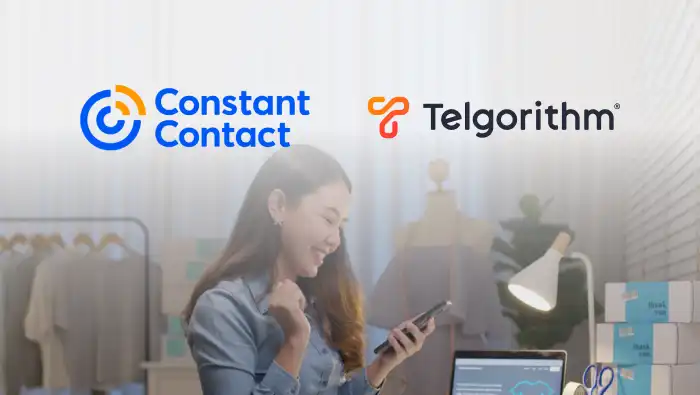BLOG POST
Published: November 10, 2023
SOS: 10DLC Compliance & Rejections FAQs Answered to Get You Approved
Written by: Telgorithm Expert

Expert Guidance on 10DLC Compliance and Brand & Campaign Rejections
Software providers offering SMS & MMS text messaging on local numbers, AKA 10-digit long code (10DLC) numbers, have been navigating new regulations and deadlines around 10DLC registration with The Campaign Registry (TCR).
If you've been working to get customers registered, you've likely been experiencing the mounting challenges and frustrations around getting Brands and Campaigns approved by Direct Connect Aggregators (DCAs) in order to send fully-compliant A2P text messages.
Because this process is nuanced and has posed many challenges for businesses, Telgorithm hosted a live Q&A to provide guidance on the most common questions and challenges software companies are facing with 10DLC compliance.
Our live Q&A was hosted by Aaron Alter, CEO and Co-founder of Telgorithm, seasoned telecom expert and 10DLC thought leader, as well as Zahidul Hasan, Customer Success and Implementation Manager who is our boots on the ground and guides customers through 10DLC and rejection challenges daily.
If you are struggling with the SMS registration process, keep reading as the top questions covered in our Q&A may be helpful for your team to get your customers approved the first time around.
If you have more specific questions or need immediate help, reach out to our team directly.
Intro to the Biggest Challenges in 10DLC Compliance from the Experts
We’ll start with the most common errors Telgorithm sees on a daily basis with A2P 10DLC compliance, because if a few people are struggling, it's likely others are too.
1. The difference between Campaign Service Providers (CSP) & Resellers
Registering as a CSP means your company remains the primary user of the TCR. Once you complete 10DLC registration as a CSP, you’ll be able to create multiple Brands (your customers) and launch their A2P messaging campaigns (your customer’s use cases). With full control, you’ll be alerted and have direct access to see why a Brand or Campaign has been rejected so you can help your customers faster. Resellers, on the other hand, leave the control with their API provider.
So if you’re leaving it up to your messaging API provider to alert you when a Campaign has been rejected and they aren’t even getting back to you – you put your team in a tough spot.
Telgorithm strongly recommends completing A2P registration as a CSP in TCR.
2. Newest updates to DCA requirements
Now if only it were that simple. New changes to vetting can be rolled out at any time by the DCAs so it’s important to stay in the loop on any updates. It’s also extremely important to partner with a provider who is committed to guiding you and educating you through this evolving process. That said, below are the newest updates to DCA requirements as of Oct. 2023:
- Privacy Policy is now mandatory for all sizes of companies (all verticals), with the exception of Sole Proprietorship. You also must clarify in the Privacy Policy if data sharing with third parties occurs or not. You are not allowed to share data with third parties for marketing or promotion purposes.
- Message frequency must be mentioned in the Opt-in sample message. Pro tip: Okay to say 'Message frequency depends on your activity'. (Brand information not required.)
- "Message & Data rates may apply" must be included in the Opt-in message disclosure.
- CTA Section must be 40 characters minimum. The CTA should be clear and include at least one place Opt-in is being gathered and stored. In other words, you must list at least one place you collect SMS Opt-in, but Telgorithm strongly recommends including all.
Q&A With Real Software Companies Just Like You
Below is a selection of relevant questions we received from our Q&A attendees. The most common topics included rejections caused by incomplete or incorrect Campaign descriptions, CTA sections, and sample messages.
#1 - CTA Section:
QUESTION: “If you have multiple SMS Opt-in channels available to end users, do all of them need to be mentioned and explained in the CTA section?”
ANSWER: Technically, no. The CTA section requirements need to include at least one place Opt-in is being gathered and stored.
But, for example, if you collect Opt-in in-person and online and you only list the in-person Opt-in in your CTA section, but your online webform has a mandatory phone number field with no SMS Disclosure or Privacy Policy, you will be rejected. Every Opt-in method you use must be compliant, whether you list them or not; DCAs review your Brand website as part of their vetting process and will definitely catch these issues.
So while you’re only required to list at least one place you collect Opt-in, Telgorithm strongly recommends including all (and making sure they’re all compliant!).
#2 SMS Opt-in Methods:
QUESTION: “If Opt-in is only collected “in person” would that ever get approved?”
ANSWER: Yes. This would be listed in the CTA section, which must be 40 characters minimum and should be clear and include at least one place Opt-in is being gathered and stored. If Opt-in is being gathered in-person, your CTA section should list exactly how Opt-in is being collected verbally (e.g. the script that is read over the phone, the language on the in-person form during a check-in). Be as detailed as possible.
But, as shared above, if you do have any webforms that require phone numbers, you must have a complete SMS Disclosure near the form (and a link to your Privacy Policy). If you don’t have a webform at all, still make sure your Privacy Policy is available and complete.
#3 Using Websites in SMS Messages:
QUESTION: “Does the URL used in the Campaign Sample Messages have to be the Brand’s domain? Would a Tinyulr (or other link shortener) lead to a rejection?”
ANSWER: Yes, a shorter version of the URL would receive a rejection. This is true for all Sample Messages in the Campaign, as well as when sending live messages to end users – DCAs will flag this and could block or suspend messages. You must use the Brand’s official domain.
#4 Internal A2P Text Messaging:
QUESTION: “If a business is sending messages only to their own staff (not their customers) - e.g. "server X is down", what is the simplest way to prove opt-in SMS compliance?”
ANSWER: This should be treated the same way as with customers, meaning you must be able to prove legitimate opt-in consent from your employees in the CTA section. For example, you might say that your employees give opt-in consent in their contract, which includes full SMS Disclosure, and include a screenshot of this contract or form in a Google Drive link for DCA to review.
The Importance of Good Customer Support
42% of our Q&A attendees reported that their providers have gone radio silent on them regarding rejection challenges, which puts them at a standstill.
These rejection errors are not all that easy to understand or navigate if you don't eat, sleep, and breathe A2P 10DLC. Instead of being expected to become an expert overnight, partner with a messaging API provider who is committed to guiding you through all the changes and keeping you informed.
It’s extremely important to have good, communicative and fast customer support in the A2P messaging industry due to all the SMS rules and regulations nuances.
Staying Informed = Staying Approved.
At Telgorithm, you’ll get a dedicated support rep and direct lines of communication, meaning your problems are solved faster and your customers stay happy.
Book a call now and get help from Telgorithm’s unmatched customer support experts today.
Latest news
Subscribe to our newsletter.
Navigate the cloud communications world with knowledge. Subscribe to our blog newsletter to receive the latest industry news, tips, and guidance.
By clicking the submit button below, I hereby agree to and accept Telgorithm’s terms and conditions.


